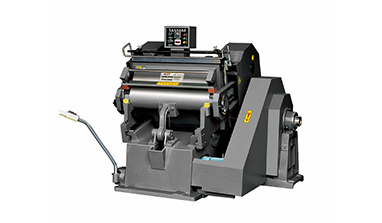In the world of printing, packaging, and various crafting industries, a manual die cutter is a valuable tool that plays a crucial role in shaping and cutting materials with precision.

A manual die cutter is a mechanical device designed to cut and shape materials, such as paper, cardboard, leather, fabric, and thin plastics, into specific patterns or shapes. The key feature that sets it apart is its reliance on manual operation, meaning that the user directly applies force to execute the cutting process. This is in contrast to automated or electric die - cutting machines, which are powered by motors or other electrical components.
The manual die cutter typically has a sturdy frame, often made of metal. This frame provides the necessary support and stability for the entire machine. It holds all the other components in place and ensures that the cutting process occurs in a controlled and accurate manner. For example, a steel - framed manual die cutter can withstand the pressure exerted during the cutting operation without deforming, thus maintaining the precision of the cut.
There is a flat and smooth cutting platform where the material to be cut is placed. This platform is designed to be durable and resistant to scratches and wear. It may have markings or guides to help the user position the material accurately. In some cases, the platform can be adjusted in height or angle to accommodate different types of materials or cutting requirements.
A crucial part of the manual die cutter is the die - holding mechanism. This is where the die, which is a custom - made tool with a specific shape or pattern, is attached. The die is usually made of hardened steel or other durable materials and has sharp edges that will cut through the material. The die - holding mechanism ensures that the die is firmly in place during the cutting process and can be easily changed when different shapes or patterns are required.
To operate the manual die cutter, there is a lever or handle. When the user applies force to the lever or handle, it transmits this force to the cutting mechanism. The design of the lever or handle is often ergonomic, allowing the user to apply force comfortably and efficiently. Some manual die cutters may also have a locking mechanism for the lever to keep it in a certain position during the cutting operation.
The working principle of a manual die cutter is relatively straightforward. First, the user selects the appropriate die and attaches it to the die - holding mechanism. Then, the material to be cut is placed on the cutting platform in the correct position, aligned with the die. Next, the user applies downward force on the lever or handle. As the force is applied, the die is pushed down onto the material. The sharp edges of the die penetrate the material, cutting it according to the shape of the die. Once the cutting is complete, the user releases the force on the lever or handle, and the die returns to its original position.
Manual die cutters find applications in a wide range of fields. In the printing and packaging industry, they are used to create custom - shaped boxes, labels, and packaging inserts. For example, a small - scale packaging company might use a manual die cutter to create unique - shaped boxes for handmade products. In the crafting and scrapbooking community, manual die cutters are popular tools for creating decorative elements, such as intricate paper shapes, fabric flowers, and leather accents. Artists may also use them to cut stencils for painting or print - making. Additionally, in some educational settings, manual die cutters are used for art and craft projects, allowing students to explore their creativity and learn about precision cutting.
Cost - Effective: Manual die cutters are generally more affordable compared to their automated counterparts. This makes them an attractive option for small businesses, hobbyists, and those on a tight budget.
Portability: They are often lightweight and compact, making them easy to move around and store. This portability is especially useful for crafters who may need to take their tools to different locations, such as craft fairs or workshops.
Precision for Small - Scale Work: For small - scale projects or when a high level of precision is required for a limited number of cuts, manual die cutters can provide excellent results. The user has direct control over the cutting process, which can be beneficial for intricate designs.
Time - Consuming: Manual operation means that the cutting process is relatively slow compared to automated machines. This can be a drawback when large quantities of materials need to be cut.
Physical Strain: Repeatedly applying force to the lever or handle can cause physical fatigue, especially when using the manual die cutter for extended periods. This may limit the amount of work that can be done in a single session.
Limited Production Capacity: Due to their manual nature, manual die cutters are not suitable for high - volume production. Automated die - cutting machines can produce a much larger number of cuts in a shorter time frame.
In conclusion, a manual die cutter is a simple yet effective tool for precision cutting in various industries and creative pursuits. While it has its limitations in terms of speed and production capacity, its cost - effectiveness, portability, and precision for small - scale work make it a valuable addition to many workspaces.
GET A QUOTE